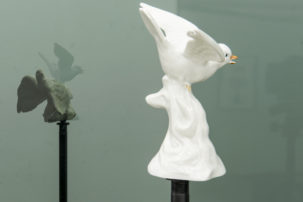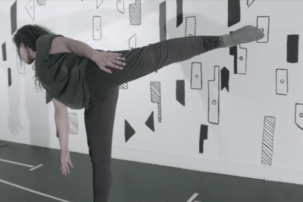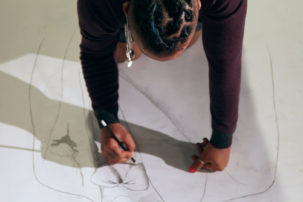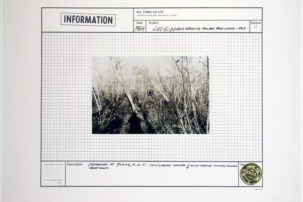In the last three years, James Carl and I have completed Chinese translations of Rosalind Krauss’s Passages in Modern Sculpture (1977) and Dan Graham’s Rock My Religion (1993). We also co-translated Lucy Lippard’s Six Years: The Dematerialization of the Art Object from 1966 to 1972 (1973) with three other translators. These books were published in Beijing as part of Translations in Modern and Contemporary Sculptural Theory, an ongoing series of critical and historical texts related specifically to sculpture.
To announce the publication of each new translation, a conference is organized at the Central Academy of Fine Arts in Beijing to bring together local and international scholars, researchers and artists to share their work and thinking on the subject matter raised in each book. In April 2018, at the book launch of Rock My Religion and Six Years, a Canadian delegation—including myself, James Carl, Barbara Fischer and Peggy Gale—was invited to participate in the conference, with its focus on conceptual art. My presentation used Dan Graham’s pavilions and their two-way mirror construction as an analogy to parse the ambiguities that surfaced during the translation of Graham’s writing from English to Chinese. This article is inspired by the same analogy.
I am not a certified translator, nor an enthusiast of comparative linguistics for that matter. In my experience, translation started as a survival exercise and a parallel-thinking process so I could navigate the trivialities of my everyday life, mapping alien words with available experiences in order to internalize meaning. As a veteran ESL-speaker living in an English-speaking environment for 18 years and, especially, working in a cultural field that considers language and intellectual history a lifeline, I must perform translation constantly and without prejudice in order to make sense of everything for myself, and to stay grounded and informed in my bilingual world. It’s reflexive, and it’s an obsession.
When I first took up translation as a line of service I could offer others, I thought, in my optimism, that the ideal practice of translation would be transparent: meaning would be open, direct and universal; everyone could access its interior, and everyone would share the same view. In a way, this is similar to the illusion of a dictionary. At the time, I thought obscurity would be considered a failure.
Prior to the Translations in Modern and Contemporary Sculptural Theory book series, I had dealt mostly with relatively ephemeral content: live interpretation of talks and lectures, and translation of movie subtitles, exhibition materials and journal articles. In those cases, my role was anonymous, transitory, and my operation independent. This allowed me to be less concerned with how these texts functioned in a larger discourse—the individual text needed merely to achieve a degree of autonomous clarity. In other words, those translations were self-contained.
The translation of books for the series, on the other hand, especially those that deal with art history and theory, is responsible for generating disciplinary languages and cultivating intellectual propositions, which in turn may foster new local histories, theories and discourses. Translation in this scenario is no longer an isolated affair, but part of a public enterprise. Even if a book selected for the series has never been published in Chinese, relevant texts from the same intellectual milieu may have been. As a result, along with the actual translations, much of our efforts have gone into compiling a database of key names, titles and terms that appear in our books but may have been translated previously. In the case of the Rosalind Krauss translation, for instance, we were able to find Chinese translations of texts by Clement Greenberg, Michael Fried, Hal Foster and Benjamin Buchloh as our reference points for the database. This helps us from one book to the next—maintaining consistency and a sense of continuity between our selected titles. By unifying the translation of keywords, it is our hope that the fragmented sources—other book translations, online journals, personal blogs, etc.—can be connected together to generate a new discourse rather than being isolated in their own territories. To our great surprise and disappointment, the available translations of these constants seem to be a rather kaleidoscopic situation. The series has thus become a place for us to advocate for the standard translation of names and terms. We would like to think of our translations as an edition of translator’s notes—not a decisive voice, but a stopover in an ongoing process of instigating and rewriting.
The act of translation in the context of conceptual art is no longer limited to a cerebral exercise; it is also sensual.
The first related conference was held at the Central Academy of Fine Arts in Beijing in December 2016 for the launch of the Chinese translations of Krauss’s Passages in Modern Sculpture and William Tucker’s The Language of Sculpture. All of the speakers received the book manuscripts beforehand to help prepare for their presentations, and the conference was so well attended, largely by students and teachers, that the lecture hall ran out of space. The organizers had to open an adjacent room and projected a live-feed of the proceedings to accommodate the audience. I was sitting in that room, watching the big screen. The door between the two rooms was left open. Simultaneously one could hear the actual voice of the presenter from the first room and the transmitted voice coming from the live-feed speaker, next to the screen. A couple of local art historians enthusiastically scrutinized Krauss’s ideas and included extensive quotes from the book in their presentations. At that moment, I heard the words that I had chosen for the translation of Krauss’s original idea collaged into a third person’s understanding, read out loud in overlapping voices, in Chinese. The warped experience was surreal and somewhat overwhelming. It was also a revelatory moment—my belief in transparency shattered.
Translating Lucy Lippard’s Six Years was an enlightening experience, contributing as it did to my growing awareness of translation’s opacity of meaning. In the book, Lippard documents the chaotic network of ideas that has been labelled “conceptual art” in the years from 1966 to 1972. For many of the artists included in the text, the deployment of language in ideas transcends a mere means of communication. The manipulation of the phonetic features and syntax of words is as important as their semantic phenomena. The act of translation in the context of conceptual art is therefore no longer limited to a cerebral exercise; it is also sensual.
One of the co-translators we worked with is a fiction writer with a particular interest in mythology. She has a background in art history, mostly dealing with traditional forms of sculpture. It was always fascinating to read her drafts of Lippard’s text: well written, logically coherent and even meaningful, but a total misinterpretation and reinvention of the original content. She struggled to make sense of the meaning. Is such a translation achievable, or simply an attempt doomed to fail? In some way, it reminded me of Ezra Pound. T.S. Eliot once said, “Pound is the inventor of Chinese poetry for our time.” When Pound was negotiating to publish his translation of the Confucian Odes, he originally envisioned that his edition would have to include a singing key and a Chinese character text facing his English translation. For Pound, the 305 odes handed down from Confucius were both songs to be sung and characters to be deciphered. Maybe that is how the translation of Six Years should be published—in a reverse trajectory—to release the idiosyncratic touch of conceptual art. But that is another book.
In summer 2017, on an art pilgrimage to Europe, I visited two of Dan Graham’s pavilions, in Münster and Berlin. At the time, we were about halfway through the translation of Graham’s Rock My Religion and I was already quite familiar with his self-description of these two-way mirror structures. Standing inside the pavilion, I found myself going through the book in my mind, searching for Graham’s instructions on how to look and be looked at, with hopes of scoring a perfect selfie with a haunting view. It was then I realized that inducing an audience’s awareness of indeterminacy had always been among the central motifs in Graham’s work. This is true even of his early writings in the 1960s, by means of semantic phenomena such as polysemy, ambiguity and puns, and is especially notable in the pieces included in the self-published collection End Moments: “My writing does not have a single point of view; instead its point of view is continually shifting, feedback contingent on its place (time and context) and its relationship to the readership who individually compose or in-form its meaning.” In Graham’s words and two-way mirror pavilion, I see the endeavour of translation—looking into a layered view of self, other and context, and drifting between the loss and rediscovery of meaning. As a medium of translingual knowledge production, translation thrives in its indeterminacy.

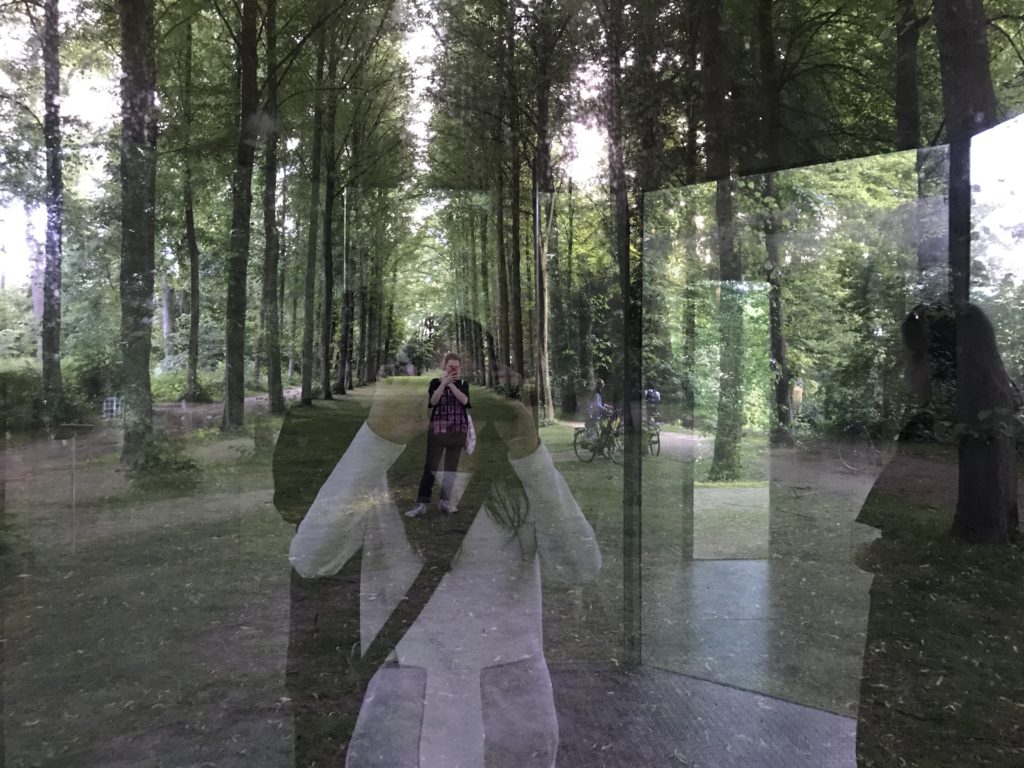 Selfie, standing inside Dan Graham's pavilion in Münster, Germany, 2017. Photo: Yan Wu.
Selfie, standing inside Dan Graham's pavilion in Münster, Germany, 2017. Photo: Yan Wu.

